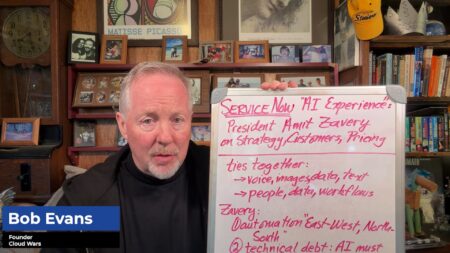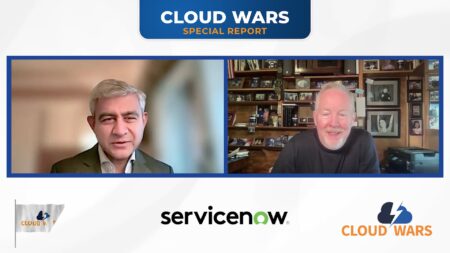As Bob Evans, the Founder of Cloud Wars and Co-Founder of Acceleration Economy, often says, “The cloud is the greatest growth market the world has ever known.” That is sure to continue in the year ahead. In fact, Gartner predicts that worldwide public cloud spending will reach close to $400 billion by the end of 2022.
Feeding into this tremendous growth are emerging purpose-built solutions for specific industries from Microsoft, SAP, Oracle, Workday, Google Cloud, Salesforce, and other providers. Further indicators of this rapid pace are highlighted by some interesting stats that each of the vendors is looking to address.
- 81% of all enterprises have a multi-cloud strategy already laid out or in the works
- 82% of the workloads will reside on the cloud
- The average person uses 36 cloud-based services every day
Disparate data sources, sprawling enterprise ecosystems, and a global user base all scream the need for purpose-built tools to enable security, scalability, creativity, flexibility, and analytical insights. With this in mind, Acceleration Economy’s Industry Cloud Battleground showcased the latest developments that leading cloud providers are delivering and a look ahead at what’s next.
DAY 1 – Analyst Roundtable Perspectives
- Intentional-built solutions. There are continued investments from each company in their solutions that align with industry needs. This approach allows the solutions to “speak the language” of the industry by delivering UI/UX, process automation, AI/ML, and more to deliver a faster time to value.
- Redefining the end-to-end experience. Previous iterations of these cloud solutions were too broad and too narrow at the same time. First, they were too broad to really build a specific solution fit for the industry and company. Second, they were too narrow in the scope of the experience. The new industry-specific solutions now encompass multi-cloud/hybrid cloud, data intelligence, edge devices, and front, middle, and back-office systems
DAY 2 – Healthcare Industry
- Keep the patient at the center. Traditionally, patient data was scattered across many disparate systems which caused bottlenecks in a patient-centered experience. Operational administrators, clinicians, doctors, nurses, pharmacies, and providers all need centralized access to patient data. This approach delivers a smooth experience no matter when or where the interaction takes place.
- Managed preventable care. We are now seeing a growth in available predictive data to help people with preventative information. Building on the centralized data, the patient and providers have access to ways to stay healthy, suggested medication, helpful exercise tips, nutritional guides, and more.
DAY 3 – Manufacturing Industry
- Future-proofing with digital twins. Modeling and prototyping in manufacturing used to be an extremely costly endeavor. However, digital twins allow companies to spot potential disruptions, reimagine new product opportunities, or streamline an entire supply chain.
- IoT and micro-factories. The internet of things (IoT) has given rise to mass volumes of data on everything from the shop floor to preventative maintenance, edge devices, and more. Further, IoT is being embedded in micro-factories that deliver manufacturing capabilities closer to the end customer.
DAY 4 – Financial Services Industry
- Shift from physical to digital banking. Today, many people haven’t set foot in a brick-and-mortar bank in quite some time. Virtual banks, digital wallets & currency, and financial management apps provide a new customer experience that is forcing traditional banking institutions to rethink financial services.
- Secure the process. Trust in finance is a must. People need to know their assets, physical and digital, are being protected. Protection comes in all forms such as anti-money laundering, fraud detection for credit card transactions, audit trails, and more. If the financial data isn’t secured throughout the entire process, customers will go elsewhere as they aren’t “married” to a bank, but an experience.
DAY 5 – Retail Industry
- Personalized omnichannel experiences. The pandemic shook the retail world to its core and forever changed consumer purchasing and spending habits. Storefronts were shuttered. E-commerce transactions soared. However, consumers were looking for companies and brands that catered to their specific needs, suggested helpful products or services, and engaged them across websites, social media, email, chat, and virtual shopping.
- Predict consumer trends. A big portion of the retail industry is built on predicting consumer shifts coupled with supply and demand. As such, many companies are investing in practical AI and machine learning capabilities to deliver future experiences. This in turn can build brand trust and loyalty, return customers, and viral marketing.
Consider the Big Picture
The large tech companies have gone all-in for industry cloud solutions. Yet, don’t count out the many startups and independent software vendors that are filling some of the gaps. This is your chance to review your entire tech stack, the processes, and the people to create revenue growth and employee upskilling opportunities.
Last, consider finding a trusted solutions and service partner to help you with the journey. The combination of your business acumen and the partners’ expertise will create a strong symbiotic relationship and feed innovative co-creation and ideation.






